-
ORIGINAL ARTICLE12-16-2024
Childbirth care by health professionals: conflicting practices in obstetrics
Revista Brasileira de Enfermagem. 2024;77(6):e20230129
Abstract
ORIGINAL ARTICLEChildbirth care by health professionals: conflicting practices in obstetrics
Revista Brasileira de Enfermagem. 2024;77(6):e20230129
DOI 10.1590/0034-7167-2023-0129
Views0See moreABSTRACT
Objectives:
to understand the perceptions of women and health professionals regarding childbirth care at a teaching hospital in the western state of Paraná, Brazil.
Methods:
this qualitative study employed Grounded Theory, conducted in an obstetric care service with 38 participants (women and health professionals) through semi-structured interviews.
Results:
limitations in physical infrastructure and management of care, along with the women’s limited knowledge about the childbirth process and the decision-making and guidance of professionals, show conflicting obstetric practices-a discrepancy between good practices and obstetric violence. Training in obstetric nursing and active participation in care, alongside the presence of a companion, were identified as intervening conditions and strategies in the process.
Final Considerations:
childbirth care is characterized by dichotomous practices. While some professionals base their practices on scientific evidence, others rely on teachings and experiences from the time of their training.
-
12-16-2024
Religión y experiencia profesional: ¿Serán predictores de la inteligencia espiritual de los enfermeros? Estudio transversal
Revista Brasileira de Enfermagem. 2024;77(6):e20240217
Abstract
Religión y experiencia profesional: ¿Serán predictores de la inteligencia espiritual de los enfermeros? Estudio transversal
Revista Brasileira de Enfermagem. 2024;77(6):e20240217
DOI 10.1590/0034-7167-2024-0217es
Views1See moreRESUMEN
Objetivos:
analizar la relación entre religión y experiencia profesional con la inteligencia espiritual en enfermeros.
Métodos:
estudio transversal y analítico realizado en 2021, participaron 544 profesionales de enfermería que laboraban en establecimiento de salud de Perú durante la pandemia por COVID-19. Para el análisis de los datos se emplearon el análisis de regresión múltiple y correlación de Pearson.
Resultados:
en los enfermeros predominó un nivel de inteligencia espiritual saludable (42,8%). Quienes no profesaban una religión tenían mayor probabilidad de tener menor puntaje de inteligencia espiritual (escala global y dimensiones); sin embargo, los enfermeros expertos tuvieron mayor probabilidad de tener mayor inteligencia espiritual (escala global y dimensiones) que los enfermeros novatos (p<0,05).
Conclusiones:
la inteligencia espiritual en los enfermeros fue predicha por la religión y la experiencia profesional. Este hallazgo sugiere que la inteligencia espiritual en enfermería se consolida mediante prácticas religiosas y durante el ejercicio profesional.
-
12-16-2024
A relação entre gênero, formação educacional e ambiente de aprendizagem com a ansiedade do estudante de enfermagem
Revista Brasileira de Enfermagem. 2024;77(6):e20220615
Abstract
A relação entre gênero, formação educacional e ambiente de aprendizagem com a ansiedade do estudante de enfermagem
Revista Brasileira de Enfermagem. 2024;77(6):e20220615
DOI 10.1590/0034-7167-2022-0615
Views1See moreRESUMEN
Objetivos:
identificar las variables asociadas a la práctica clínica relacionadas con la ansiedad de los estudiantes de enfermería.
Métodos:
se utilizó un diseño descriptivo, cuantitativo, correlacional con las recomendaciones STROBE, EQUATOR. La población fue de 233 estudiantes de enfermería con una muestra de 135 personas. Los datos se recopilaron de marzo a abril de 2022 utilizando instrumentos validados.
Resultados:
la prueba de chi-cuadrado y razón de verosimilitud significativa para género, formación académica y entorno de aprendizaje son superiores a 0.05, por lo que no existe una relación significativa entre las variables y la ansiedad de los estudiantes.
Conclusiones:
los estudiantes necesitan prepararse nuevamente antes de ingresar al campo de la práctica. Investigaciones cualitativas también son necesarias.
-
ORIGINAL ARTICLE12-16-2024
Bladder ultrasound: evidence of content validity of a checklist for training nurses
Revista Brasileira de Enfermagem. 2024;77(6):e20230183
Abstract
ORIGINAL ARTICLEBladder ultrasound: evidence of content validity of a checklist for training nurses
Revista Brasileira de Enfermagem. 2024;77(6):e20230183
DOI 10.1590/0034-7167-2023-0183
Views0See moreABSTRACT
Objectives:
to develop and analyze evidence of content validity of a checklist for training nurses in measuring bladder volume through ultrasound.
Methods:
a methodological study, consisting of three stages: literature review; instrument item preparation; and analysis of evidence of content validity. The Content Validity Index (CVI) and Gwet’s AC2 were used for content validity analyses.
Results:
the checklist consisted of 23 items. The CVIs for clarity, relevance and dimensionality were 0.99, 0.99 and 0.98 respectively, and the CVIs for Gwet’s AC2 with coefficients for clarity, relevance and dimensionality were 0.89, 0.97 and 0.95, respectively, with p<0.001.
Conclusions:
the checklist developed for training nurses in measuring bladder volume through ultrasound achieved adequate evidence of content validity, and can be used to train nurses in clinical practice and future research.
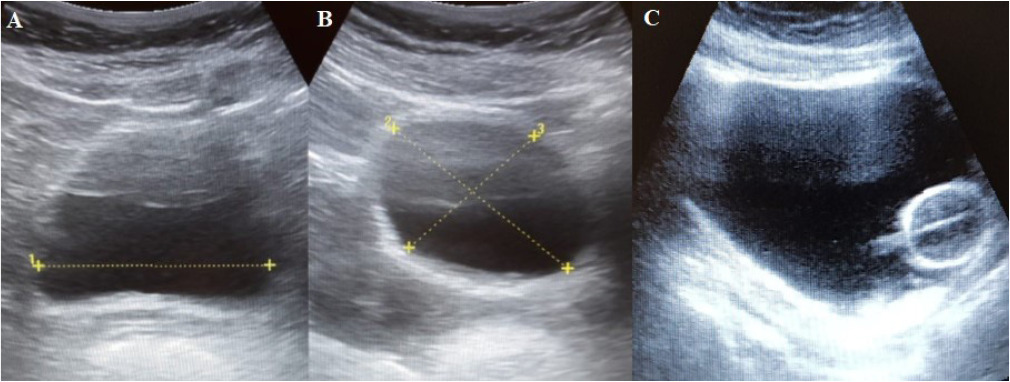
-
ORIGINAL ARTICLE12-16-2024
Nursing team’s perceptions about care for pregnant women in a psychiatric unit
Revista Brasileira de Enfermagem. 2024;77(6):e20230186
Abstract
ORIGINAL ARTICLENursing team’s perceptions about care for pregnant women in a psychiatric unit
Revista Brasileira de Enfermagem. 2024;77(6):e20230186
DOI 10.1590/0034-7167-2023-0186
Views0See moreABSTRACT
Objectives:
to understand the nursing team’s perception in relation to the care provided to pregnant women with mental disorders admitted to a psychiatric hospital unit.
Methods:
Convergent Care Research carried out between August and December 2021, through semi-structured interviews with 25 nursing professionals from a Psychiatric Unit from a reference Hospital in Southern Brazil.
Results:
the organized and analyzed data resulted in two thematic categories: Technical, generic and impersonal care; and From impersonality to the singularity of nursing care. Ensuring unique care for pregnant women with mental disorders means giving them a meaning of existence and providing care from a multidimensional and continuous perspective.
Final Considerations:
nursing care for pregnant women in psychiatric hospitalization requires continuous professional qualification, interactive technologies and support for the nursing process, in addition to promoting singular and multidimensional care.
-
ORIGINAL ARTICLE12-16-2024
The nursing practice environment and hospital sociotechnical complexity: a mixed-methods study
Revista Brasileira de Enfermagem. 2024;77(6):e20230315
Abstract
ORIGINAL ARTICLEThe nursing practice environment and hospital sociotechnical complexity: a mixed-methods study
Revista Brasileira de Enfermagem. 2024;77(6):e20230315
DOI 10.1590/0034-7167-2023-0315
Views1See moreABSTRACT
Objectives:
to analyze the relationship between the nursing practice environment and hospital sociotechnical complexity as perceived by nurses.
Methods:
a sequential explanatory mixed-methods study was conducted in a hospital in southern Brazil. The Brazilian version of the Practice Environment Scale-Nursing Work Index and the Complexity Characterization Questionnaire were administered to 132 nurses. Subsequently, semi-structured interviews were conducted with 18 participants, and the data were subjected to thematic analysis. Data integration was achieved through a connection approach.
Results:
the nursing practice environment was found to be favorable, except in the subscale concerning Staffing and Resource Adequacy, where complexity was present in the activities. The three emerging categories explained human and technical aspects related to complexity in the practice environment, quality of care, and patient safety. Unexpected variability was inversely correlated with the practice environment.
Conclusions:
the study results indicate a relationship between these constructs, with implications for the quality and the safety of care.
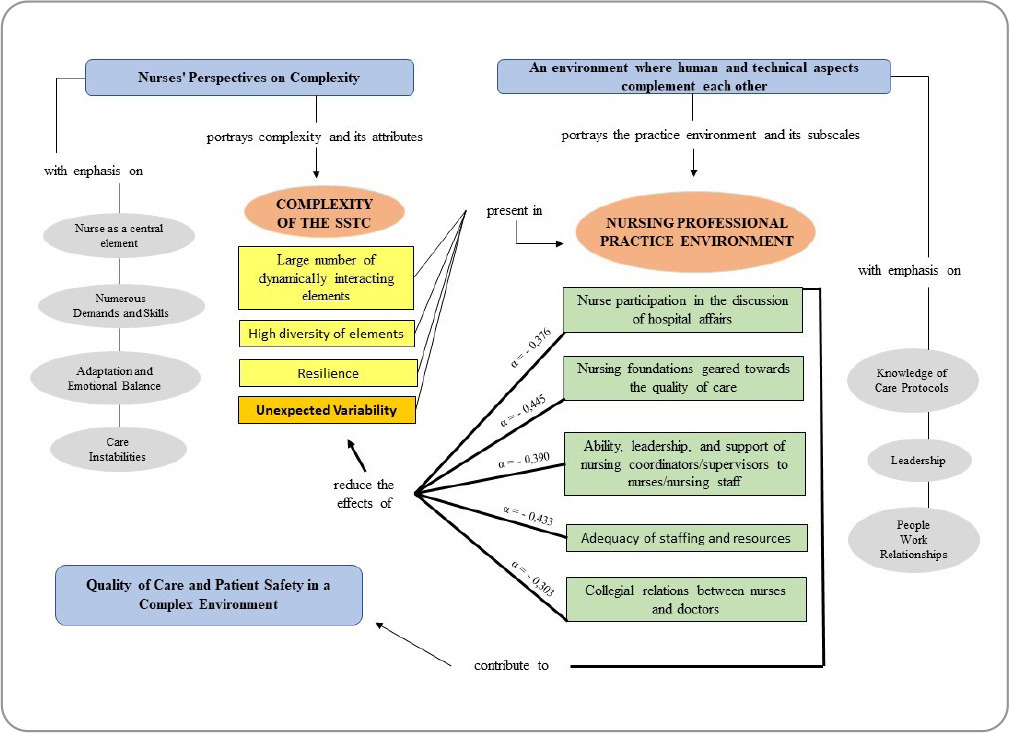
-
ORIGINAL ARTICLE12-16-2024
Factors associated with maternal well-being during childbirth among postpartum women in Minas Gerais
Revista Brasileira de Enfermagem. 2024;77(6):e20230304
Abstract
ORIGINAL ARTICLEFactors associated with maternal well-being during childbirth among postpartum women in Minas Gerais
Revista Brasileira de Enfermagem. 2024;77(6):e20230304
DOI 10.1590/0034-7167-2023-0304
Views0See moreABSTRACT
Objectives:
to analyze the factors associated with maternal well-being during childbirth among postpartum women in Minas Gerais.
Methods:
a cross-sectional study nested within a cohort was conducted with postpartum women in a municipality of Minas Gerais. The Maternal Well-being in Childbirth Scale 2 was used. The prevalence of maternal well-being during childbirth was estimated. The magnitude of the association between maternal distress and care practices was estimated using the Prevalence Ratio (PR), applying Poisson regression.
Results:
a total of 183 postpartum women aged between 15 and 46 years participated, with 26.2%, 27.9%, and 45.9% reporting excellent, adequate, and poor well-being during childbirth care, respectively. Maternal distress was more prevalent among women who underwent cesarean sections (PR = 1.60) and those who did not receive breastfeeding information (PR = 1.59).
Conclusions:
a high prevalence of maternal distress during childbirth was observed, associated with cesarean delivery and the lack of breastfeeding information.
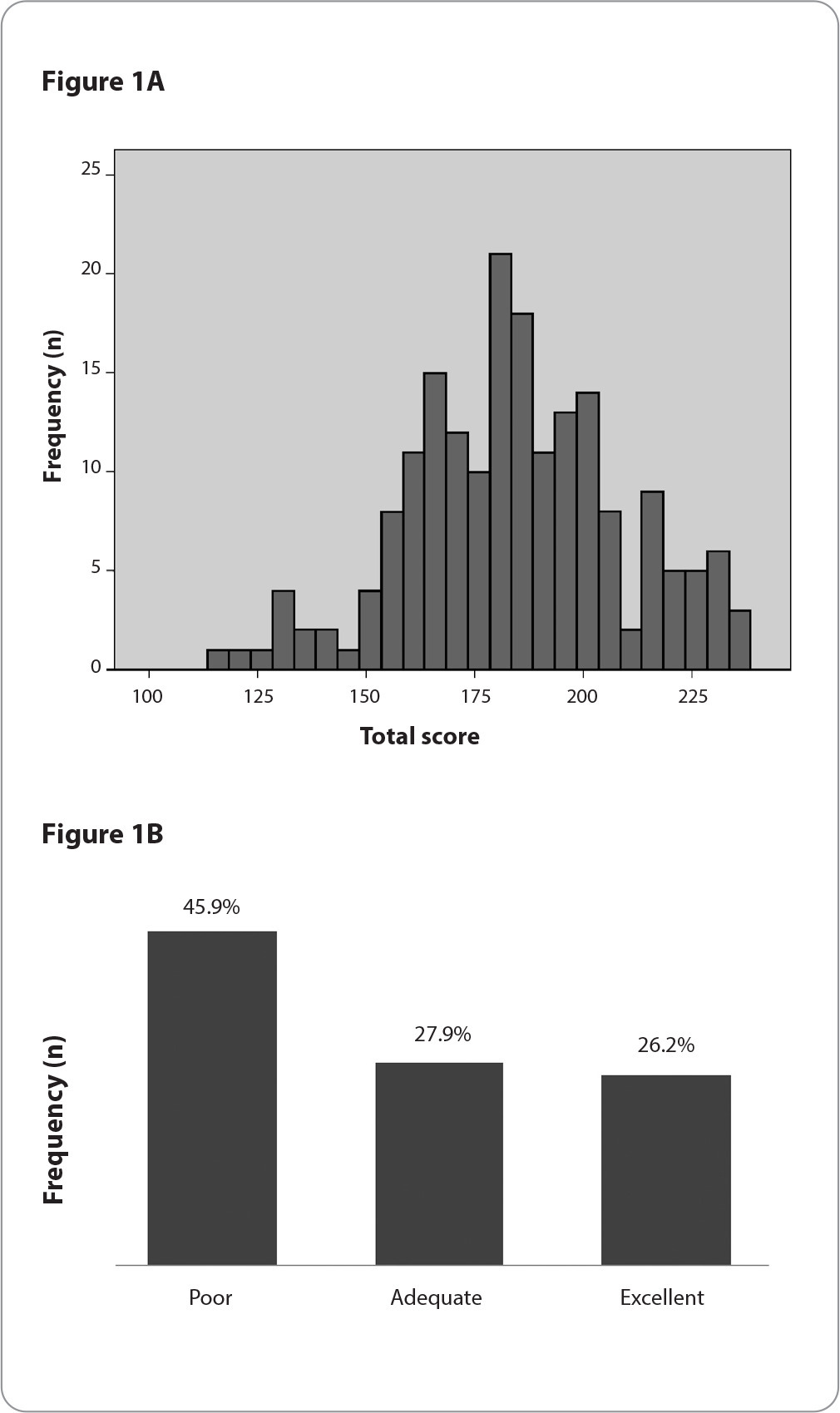
-
ORIGINAL ARTICLE12-16-2024
Prevalence and factors associated with musculoskeletal pain among hospital cleaning staff
Revista Brasileira de Enfermagem. 2024;77(6):e20230237
Abstract
ORIGINAL ARTICLEPrevalence and factors associated with musculoskeletal pain among hospital cleaning staff
Revista Brasileira de Enfermagem. 2024;77(6):e20230237
DOI 10.1590/0034-7167-2023-0237
Views0See moreRESUMO
Objetivos:
verificar a prevalência e os fatores associados à dor musculoesquelética em trabalhadores do serviço hospitalar de limpeza.
Métodos:
estudo transversal, realizado com trabalhadores de limpeza de um hospital de ensino do Sul do Brasil. Utilizaram-se questionário com variáveis sociodemográficas, laborais e de saúde, o Nordic Musculoskeletal Questionnaire e o Diagrama de Corlett e Manenica. Realizou-se análise bivariada.
Resultados:
participaram 149 trabalhadores. Prevaleceu dor musculoesquelética na coluna lombar no último ano (65,8%) e últimos sete dias (42,3%). Constataram-se associações entre automedicação e dor na parte inferior das costas (p=0,020) e ombros (p=0,026); sedentarismo, oito horas de sono diárias e dor nos tornozelos (p=0,041) e pés (p=0,039); ex-tabagismo, uso de medicamento e dor nos punhos (p=0,015) e mãos (p=0,004).
Conclusões:
prevaleceram lombalgias associadas a hábitos de saúde e vida. Um programa de educação em saúde e recomendações de melhorias nos processos de trabalho podem minimizar a exposição à dor musculoesquelética.
-
REFLECTION02-05-2021
The vulnerability of the family: reflections about human condition
Revista Brasileira de Enfermagem. 2021;74(1):e20190412
Abstract
REFLECTIONThe vulnerability of the family: reflections about human condition
Revista Brasileira de Enfermagem. 2021;74(1):e20190412
DOI 10.1590/0034-7167-2019-0412
Views0See moreABSTRACT
Objectives:
to reflect about the vulnerability of the family, using the book The Human Condition by Hannah Arendt as reference, to better understand how this institution has been structured in today’s world.
Results:
the rupture of assistance relations among family members represents a situation of vulnerability that weakens the family institution, leading to the loss of the assertiveness in the society. Support for the development of human capabilities in families and in the territory provides the benefit of strengthening them to face of vulnerabilities.
Conclusions:
the vulnerability of the family presents itself as a historic milestone, condition on which the family institution was built and organized as a public and private property, putting in evidence the importance to develop a more holistic and integrate care to the people, based on health public policies and social assistance.
-
ORIGINAL ARTICLE08-20-2022
Innovative actions developed by nurses in primary health care
Revista Brasileira de Enfermagem. 2022;75(1):e20200782
Abstract
ORIGINAL ARTICLEInnovative actions developed by nurses in primary health care
Revista Brasileira de Enfermagem. 2022;75(1):e20200782
DOI 10.1590/0034-7167-2020-0782
Views0See moreABSTRACT
Objectives:
to understand the work process dimensions related to innovative actions developed by nurses in Primary Health Care.
Methods:
qualitative, descriptive study, developed in Primary Health Care in a city in the Southern Region of Brazil. Seventy-six nurses, who worked in management and assistance, participated in this study through semi-structured interviews. After data processing by IRAMUTEQ software, the textual analysis occurred by descending hierarchical classification.
Results:
forty-two innovative actions, considered by the participants as new ways of working, were identified. There was a predominance of innovative actions related to the Management and Assist dimensions; we noticed the fragility of the actions to contemplate all the nurse’s work process dimensions.
Final Considerations:
the predominance of innovative actions was related to users’ assistance and better conditions in the teamwork process, besides highlighting the role of nurses in the perspective of a new way of working in health services.
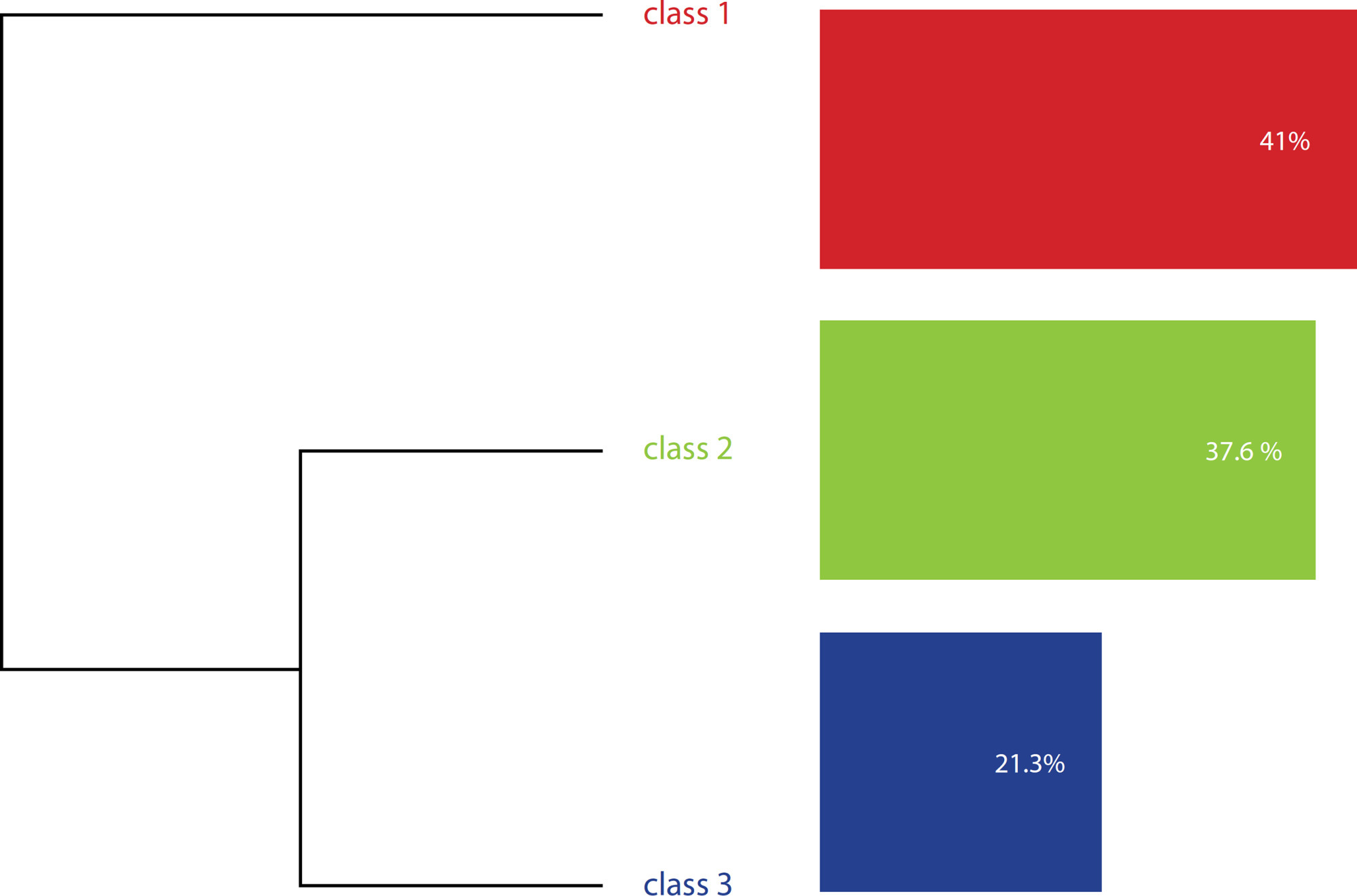
-
ORIGINAL ARTICLE04-22-2020
Beliefs related to insulin use in people with Type 2 Diabetes Mellitus
Revista Brasileira de Enfermagem. 2020;73(3):e20190029
Abstract
ORIGINAL ARTICLEBeliefs related to insulin use in people with Type 2 Diabetes Mellitus
Revista Brasileira de Enfermagem. 2020;73(3):e20190029
DOI 10.1590/0034-7167-2019-0029
Views0See moreABSTRACT
Objectives:
to identify the beliefs of people with Type 2 Diabetes Mellitus related to insulin use.
Methods:
a descriptive, cross-sectional, quantitative-qualitative study based on Theory of Planned Behavior and performed with 32 participants using insulin. The data were analyzed and grouped into categories by beliefs similarity, counted from the frequencies.
Results:
118 behavioral, 60 normative and 97 control beliefs were issued. Among the behavioral beliefs, there was an advantage in keeping the diabetes under control and disadvantage, the pain of being pierced by the application of insulin. Regulations highlighted the children as referents who support the treatment. In control beliefs, it was observed that the application of insulin appears as easiness and difficulty to the treatment.
-
01-20-2021
Psychic burden development related to nursing work in Psychosocial Care Centers
Revista Brasileira de Enfermagem. 2021;74:e20200114
Abstract
Psychic burden development related to nursing work in Psychosocial Care Centers
Revista Brasileira de Enfermagem. 2021;74:e20200114
DOI 10.1590/0034-7167-2020-0114
Views0See moreABSTRACT
Objective:
to investigate the factors that are present in the work environment of the nursing team and that contribute to emergence of psychic burden in Psychosocial Care Centers III.
Methods:
this is a descriptive and qualitative study carried out in three services located in Paraíba State. Data were obtained from an interview with a semi-structured script, and textual content was treated using the software Interface de R pour Analyzes Multidimensionnelles de Textes et de Questionneires.
Results:
the factors that trigger psychic burden arise primarily from pace of work, precarious physical structure, work with users in mental distress, lack of management support, insufficient multidisciplinary team and lack of clinical supervision.
Conclusion:
the difficulties faced by nursing professionals in the work environment cause suffering at work and hinder the effectiveness and, consequently, the quality of nursing care.

-
REVIEW07-13-2020
The quality of life of family health professionals: a systematic review and meta-synthesis
Revista Brasileira de Enfermagem. 2020;73(5):e20190645
Abstract
REVIEWThe quality of life of family health professionals: a systematic review and meta-synthesis
Revista Brasileira de Enfermagem. 2020;73(5):e20190645
DOI 10.1590/0034-7167-2019-0645
Views1See moreABSTRACT
Objectives:
to perform a systematic review and meta-synthesis of qualitative studies about the work-related quality of life of Family Health Strategy professionals.
Methods:
this systematic review was developed to answer the following PVO question: “Which factors (variables) are associated with the work-related quality of life (outcome) of Family Health Strategy professionals (population)?” The PubMed, Scopus, Embase, SciELO, Web of Science, LILACS, Science Direct, OpenThesis, OpenGrey, and OATD databases were selected. The meta-synthesis analyzed the main codes and secondary codes of all included studies.
Results:
the database search resulted in 1,744 reports; six were considered eligible for the meta-synthesis. Four factors were considered for the quality of work life: working conditions; work processes; interpersonal relationships; and personal aspects.
Conclusions:
although this study confirms the adequacy of aspects commonly related to the quality of work life, other factors are important in the case of FHS professionals, especially work context.
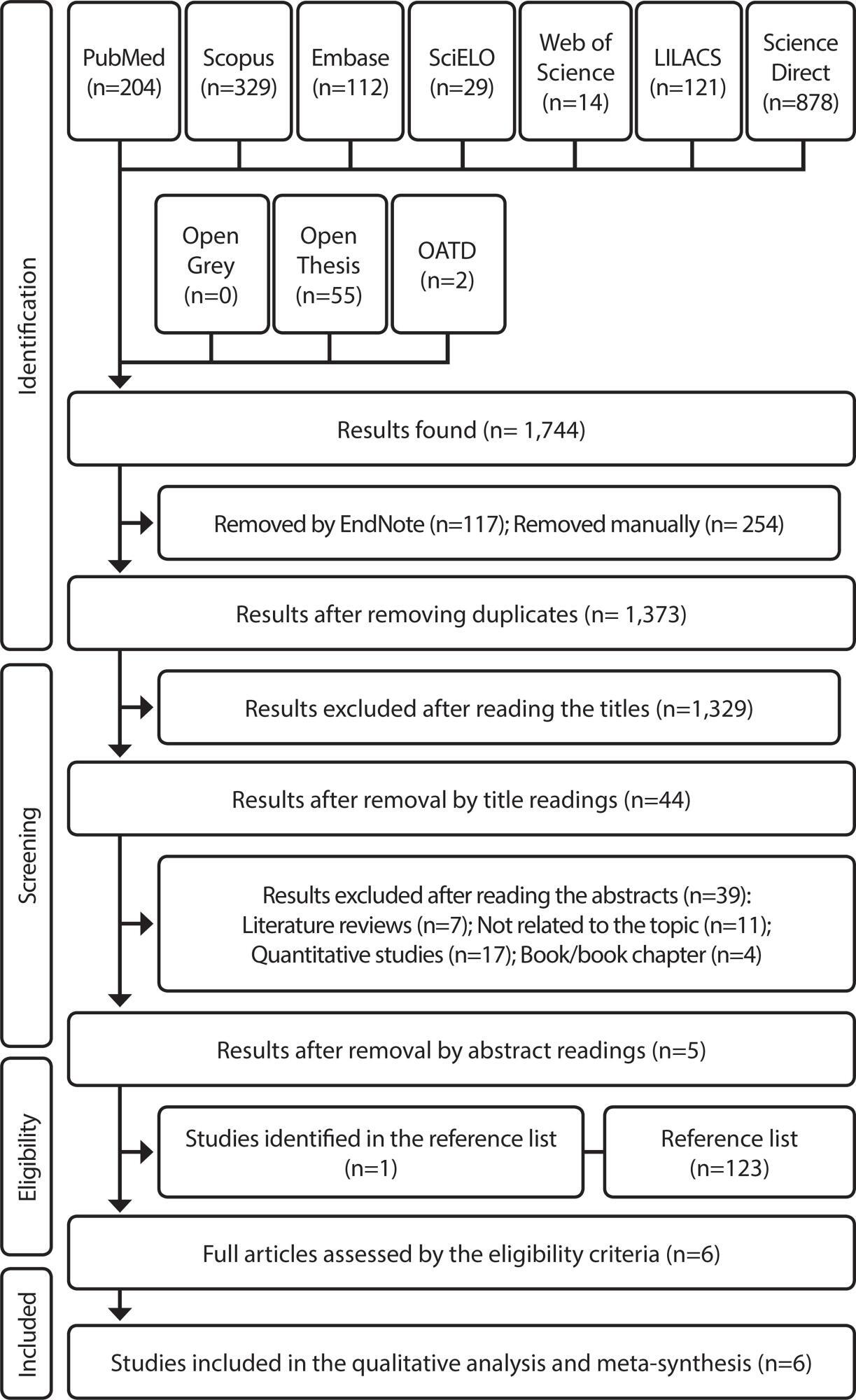
-
ORIGINAL ARTICLE04-22-2020
Evaluation of user embracement software with pediatric risk classification
Revista Brasileira de Enfermagem. 2020;73(3):e20180677
Abstract
ORIGINAL ARTICLEEvaluation of user embracement software with pediatric risk classification
Revista Brasileira de Enfermagem. 2020;73(3):e20180677
DOI 10.1590/0034-7167-2018-0677
Views0See moreABSTRACT
Objective:
to evaluate functional performance and technical quality of user embracement software with pediatric risk classification.
Method:
descriptive exploratory study developed based on the quality requirements set forth in ISO/IEC 25010. The evaluated characteristics were: functional adequacy, reliability, usability, performance efficiency, compatibility, safety, maintainability and portability. Eight specialists from the area of informatics and 13 from nursing participated in the evaluation. The characteristics were considered adequate when they reached more than 70% of indication as very and/or completely appropriate in the evaluations of each group of specialists.
Results:
The results obtained from the evaluation of informatics and nursing specialists were: functional adequacy (100.0%, 96.2%), reliability (82.6%, 88.5%), usability (84.9%; 98.7%), performance efficiency (93.4%; 96.2%), compatibility (85.0%, 98.1%), safety (91.7%, 100.0%), and, yet, maintainability (95.0%) and portability (87.5%) evaluated by the first ones.
Conclusion:
the software was considered adequate regarding technical quality and functional performance.
-
ORIGINAL ARTICLE04-07-2023
Spiritual well-being, symptoms and performance of patients under palliative care
Revista Brasileira de Enfermagem. 2023;76(2):e20220007
Abstract
ORIGINAL ARTICLESpiritual well-being, symptoms and performance of patients under palliative care
Revista Brasileira de Enfermagem. 2023;76(2):e20220007
DOI 10.1590/0034-7167-2022-0007
Views0See moreABSTRACT
Objectives:
to assess the relationship between spiritual well-being, symptoms and performance of patients under palliative care.
Methods:
this is a descriptive correlational study, conducted with 135 patients seen in palliative care outpatient clinics. Karnofsky Performance Status Scale, Edmonton Symptom Assessment Scale, Spirituality Scale and Hospital Anxiety and Depression Scale were used. Data were submitted to descriptive statistical analysis and Spearman’s correlation.
Results:
among participants, 68.2% were cancer patients. The most prevalent symptoms were changes in well-being (65.2%), anxiety (63.7%), sadness (63%) and fatigue (63%). Sadness, dyspnea, sleepiness, anxiety and depression presented weak to moderate correlation with spiritual well-being. Symptom overload showed weak negative correlation with performance.
Conclusions:
symptom intensification was correlated with worsening in spiritual well-being perception. The reduction in performance was related to increased number of symptoms, especially depression and anxiety.
-
ORIGINAL ARTICLE04-22-2020
Accuracy of the clinical indicators of ineffective health management in celiac people
Revista Brasileira de Enfermagem. 2020;73(3):e20180739
Abstract
ORIGINAL ARTICLEAccuracy of the clinical indicators of ineffective health management in celiac people
Revista Brasileira de Enfermagem. 2020;73(3):e20180739
DOI 10.1590/0034-7167-2018-0739
Views0See moreABSTRACT
Objective:
to analyze the accuracy of clinical indicators of “Ineffective health management” in celiac patients and to verify associations between sociodemographic characteristics and clinical indicators.
Method:
a cross-sectional study, conducted from May to September 2017, with 83 celiac patients, through an interview. Accuracy measures were defined by latent class model.
Results:
there was a prevalence of “Ineffective health management” of 55.69%. “Failure to take action to reduce risk factor” and “Failure to include treatment regimen in daily living” better predict this diagnosis. Paid occupation reduces the chance of the presence of “Difficulty with prescribed regimen”. Participation in support association reduces the chance of the presence of “Difficulty with prescribed regimen”, “Ineffective choices in daily living for meeting health goal” and “Failure to take action to reduce risk factor”.
Conclusion:
accurate clinical indicators identification assists clinical reasoning for diagnostic inference in specific health contexts.
Search
Search in:
Nuvem de Tags
Enfermagem (930)Cuidados de Enfermagem (269)Atenção Primária à Saúde (239)Idoso (208)Educação em Enfermagem (151)Segurança do Paciente (150)Saúde Mental (145)Educação em Saúde (139)Estudos de Validação (131)Qualidade de Vida (104)Tecnologia Educacional (100)Promoção da Saúde (99)COVID-19 (91)Criança (91)Família (87)Enfermagem Pediátrica (86)Saúde do Trabalhador (86)Adolescente (85)Saúde Pública (82)Estudantes de Enfermagem (77)



